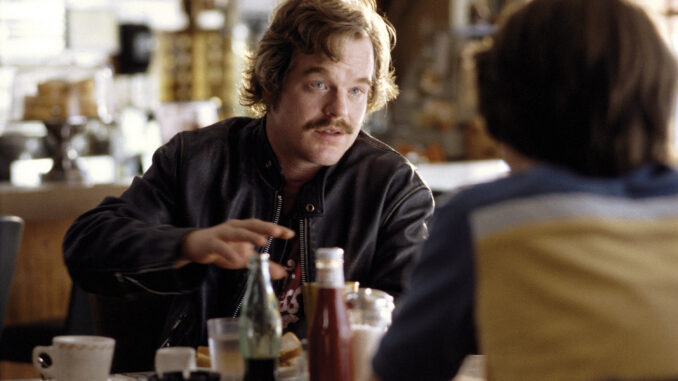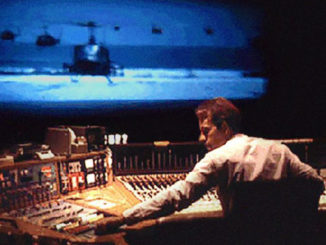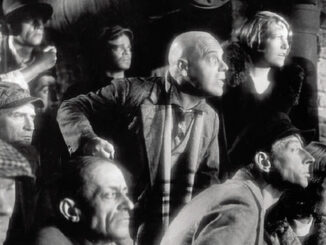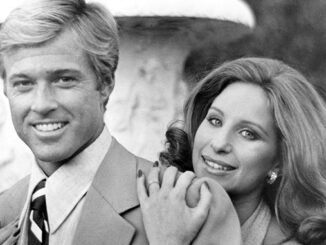
by Peter Tonguette
Scattered throughout the films of Cameron Crowe are moments in which the director’s adolescent rock wordsmith background shine through. Think of John Cusack in Say Anything… (1989) with a boom box in midair while playing Peter Gabriel’s “In Your Eyes,” or Tom Cruise in Jerry Maguire (1996) bopping his head to various tunes on his FM dial before settling on Tom Petty’s “Free Fallin’.”
While the former Rolling Stone writer needs little help in dreaming up scenes to go along with classic songs, they would not be half as memorable were it not for the handiwork of music editor Carlton Kaller. Initially working with Crowe on his debut as writer-director, Say Anything…, the two have collaborated on seven films to date. Each has its share of moments in which character and music are harmonized, but none place music front and center as strikingly as Almost Famous (2000).
In the story of William Miller (Patrick Fugit), a budding stringer for Rolling Stone assigned to track a touring, upwardly mobile band called Stillwater, Crowe borrowed explicitly from his own past. Yet the film’s summoning of rock in the late 1960s and early ’70s also struck a chord with Kaller and music supervisor Danny Bramson. “We were all there in some form or fashion through that time at the same age,” Kaller says.

Photo by Deverill Weekes
Kaller found himself relating to the film’s medley of the era’s music, from Todd Rundgren to Simon and Garfunkel. “I get so many emotional hits off of some of that stuff,” he says. “Even all the way back to the Chipmunks at the beginning of the movie — which is probably the first record I ever owned.”
Although it turned out that Crowe and Kaller were simpatico when it came to their musical reference points, their association began with a bit of behind-the-scenes intrigue. “On Say Anything…, I was hired by the studio because they didn’t trust Cameron or Danny, who were so young,” Kaller says. But instead of being the executives’ eyes and ears in the cutting room, Kaller locked the door and put himself in service of his collaborators. “Here I was suddenly with my peers, finally,” he says. “I wasn’t working for older people.”
Crowe and Kaller’s relationship of trust was especially needed on Almost Famous, which was first allocated a music budget of $350,000, which was quickly used up. (According to The Los Angeles Times, the final music budget was $3.5 million.) “I know that a million dollars was paid to Led Zeppelin for their four songs,” Kaller concedes. “And it was the first time the band had ever agreed to license a song to a film.”
But, he adds, he and Crowe try not to think of how much a song might cost, and whether there really is the money for it, as they are working. “One of the reasons to protect him from that is they start chipping away at it before it’s finished,” he says. “To keep him fresh and keep him doing what he’s doing, he doesn’t need somebody standing over him, saying, ‘You can’t use that song.’”
While not every song that spoke to Crowe ended up in the final cut, Elton John’s “Tiny Dancer” may have been non-negotiable. The song surfaces midway through Almost Famous, following a night of revelry and recriminations among William and the members of Stillwater (led by Billy Crudup’s Russell Hammond). The company has glumly taken their seats in the tour bus when the first chords of the song are heard on the radio. We see from their faces that they are taking note of the lyrics and allowing themselves to be touched by the melody. Then — in a moment film critic Michael Wilmington aptly compared to the group singing of “The Man on the Flying Trapeze” in Frank Capra’s It Happened One Night (1934) — it becomes a karaoke free- for-all. A veritable chorus forms as one person after another starts to sing with Elton John.
The scene was among the most challenging for film editors Joe Hutshing, A.C.E., and Saar Klein. “It got tossed to Saar Klein, just because it was becoming a time suck, trying to figure out how to make it work,” Kaller recalls. “Cameron and Joe plowed forward with the rest of the movie, and I went back and forth with Saar for a while.” They had been grappling with it when Kaller turned to Klein with an insight: “Hey, we’re making a chick flick for guys.” With that, Klein was able to find the emotional through-line. “He did a spectacular job with that scene,” Kaller says. “It’s the one everybody remembers.”
For Kaller, the challenge came with receiving the multi-track from Elton John’s representatives and then proceeding to remix and re-cut a 6:12 song to fit a scene that lasts about two-and-a-half minutes. The more recognizable a song is, the trickier it is to tinker with it. “Everybody knows the song,” Kaller comments. “They’re tracking it in their head when they hear it, so if you make any kind of deviation that takes you out of the formula, it’ll stop your audience.
They just immediately go, ‘No, that’s not right.’ You don’t want somebody doing that in the middle of a scene, especially when it’s important.”
Adding to the complication was the fact that actors were singing while the song was playing. “Every time they moved something around, they had to reconstruct the material between the vocals, and keep it feeling natural,” Kaller says. “Ultimately, it just became what it was. The picture had to expand into the song, and the song had to contract to the picture.”
It is easy to see why Kaller’s favorite example of a similar moment in a film is when Mike Myers and Dana Carvey turn on “Bohemian Rhapsody” in Wayne’s World (1992). “They play the whole song,” he explains.
In Almost Famous, however, a song can be part of the very marrow of a scene, even when it is only briefly heard. As William is chatting up “band aid” Penny Lane (Kate Hudson), Joni Mitchell’s “River” comes on over the PA system — just as Russell intrudes on their tête-à-tête. “It’s Penny and Russell, and they know each other,” Kaller says. “William is introducing them — not knowing that they already know each other.” As Penny plays along, fake-introducing herself to Russell as William gullibly looks on, the doleful strains of Mitchell’s song — even though we hear it for less than a minute — seem to anticipate the coming romantic complications among this trio.

Photo by Joe Hutshing, A.C.E.
“Cameron had already selected ‘River’ as the song, probably because there’s a moment where that actually happened,” Kaller says. “He played that on the set, and she cried. It killed Kate.”
For a much later scene, when William and Penny say their goodbyes in an airport after the disastrous (for them) New York leg of Stillwater’s tour, Crowe had hoped to use the Rolling Stones’ “Wild Horses.” The song was to accompany shots of William as he stands at the airport windows and finds Penny peering back at him from her seat in the plane, but when it didn’t work out, it fell to composer Nancy Wilson to fill in the blanks. “How do we stay within the score parameters that we’ve created and still get the whiff, get the intoxicating hit that ‘Wild Horses’ was giving us at this moment?” Kaller says.
Wilson achieved it, and the shorthand Kaller has developed with Crowe extends to her. “I can just bring up a song from memory and say, ‘Wouldn’t it be nice if we had something like that on top of this track at this point?’” he says. “She just plays it. She knows exactly what the lick was, how it worked, why it worked, and will give me a lick — not the same lick — but a lick very similar that evokes the same response.”
In fact, Kaller and Wilson’s experience of crafting scores that functioned like songs on Almost Famous spilled over into their work on Crowe’s next two films, Vanilla Sky (2001) and Elizabethtown (2005).
Growing up in Hollywood, Kaller says he fell into show business much as someone growing up in Detroit might fall into the car business. He was a fine arts student at the San Francisco Art Institute, but he loved film because it blended word and image. “That’s what initially attracted me,” he says. Music editor Ted Whitfield happened to live on Kaller’s street, and his role as mentor and adoptive father is what first led Kaller to the cutting room (through a job in editorial with Robert Altman’s company, Lion’s Gate) — and, eventually, to music editing specifically. “I loved him and I loved his life,” Kaller says of Whitfield. “I remember thinking, ‘If that’s as bad as it gets, then that’s good enough for me.’”
On some of his first films, Kaller would pilfer his record collection for songs as he created the temp dub. “I went to all those great musical moments that I remembered that meant things to me that I thought conveyed the emotion of the scene,” he says. “All the years spent in the basement geeking on records suddenly paid off.” He observes that “there’s a great value to songs and also a danger,” the danger coming only when they are overused.
“The emotional value of it, the putting you in the place at the time, and the feeling of it and the whole establishment that you get off of songs like that — it’s a great way to score a movie,” he says. “My approach has always been, if you dig it, someone else will dig it. If it moves you, it will move someone else. If you see a flaw in your work, someone else will see that flaw. Make yourself happy and you will make a vast audience of filmgoers happy.”
With Crowe, however, he took his approach to another level — creating scenes like so many in Almost Famous, where what is happening on screen is inseparable from what is on the soundtrack. “I always say that Cameron’s the guy that opened my eyes to the narrative power of music in film,” Kaller admits. For his work on Almost Famous, Kaller was honored with a Golden Reel Award, Best Sound Editing – Music – Musical Feature, from the Motion Picture Sound Editors.
“There’s a purity about him and a cleanness in his intention toward the world,” Kaller says of Crowe. “His application of that energy to his films; it’s palpable. You can see it. You can feel it.”
And you can hear it, too.






